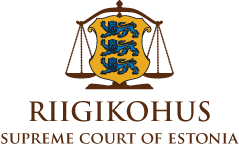 Riigikohus on Eesti Vabariigi kõrgeim kohus.
Riigikohus on Eesti Vabariigi kõrgeim kohus.
Põhiseaduse kohaselt on Riigikohus kassatsioonikohus ja
põhiseaduslikkuse järelevalve kohus. Riigikohtu pädevus
on sätestatud kohtute seaduses. 
Primary tabs
The Yearbook of the Estonian Courts 2019 examines the relationship between the administration of justice and information technology
Published in electronic format for the first time, the Yearbook of the Estonian Courts investigates, among other things, information technology developments in Estonian courts, the related trouble and increase in happiness of the judges, and what the future administration of justice could look like in a world that is becoming ever more digitalised.
“Court decisions are made digitally, judges settle disputes where a decision has been made by an algorithm or where a crime has been committed via the internet, and even court sessions – as we can see now – can be held in a digital environment,” Nele Parrest, Justice of the Supreme Court and member of the yearbook’s editorial committee, offers examples of how judges come into contact with information technology in their daily work. “To understand the developments of information technology in Estonian courts and what the ever-continuing digitalisation of society could mean for court trials, this year we have set our focus on the relationship between the courts and information technology.”
The Yearbook of the Estonian Courts opens with the annual overview by Villu Kõve, Chief Justice of the Supreme Court, on the developments in the Estonian legal and court system.
In the first article on the main topic of the yearbook, Professor of Cognitive and Legal Psychology at the University of Tartu Talis Bachmann provides an overview of the response of scientific studies to the question on the differences in the perception of the information presented on paper and digitally. In an article about the possibilities of artificial intelligence, the digital governance solutions team at Net Group asks a fundamental question whether artificial intelligence could be a substitute for or be of assistance to a judge.
The impact of the ever digitalising activities of officials on the work of administrative courts and the use of machine learning in administrative decisions are described by Ivo Pilving, Chairman of the Administrative Law Chamber of the Supreme Court and Docent of Administrative Law at the University of Tartu, and Monika Mikiver, Adviser at the Public Law Division of the Ministry of Justice and PhD student at the Faculty of Law, University of Tartu.
The yearbook also looks at information technology developments in judicial proceedings in Latvia, Lithuania and Romania. In addition to the articles on the main topic, the yearbook provides an overview of the statistics of court proceedings at all levels of the Estonian judicial system.
The Yearbook of the Estonian Courts is published by the Supreme Court. This year’s yearbook is the twelfth to be published and will be only be available digitally from this year.
Read the Yearbook of Estonian Courts here: https://aastaraamat.riigikohus.ee/en/
Susann Kivi
Press Officer
Supreme Court of Estonia
+372 5333 9846
susann [dot] kivi![]() riigikohus [dot] ee
riigikohus [dot] ee


